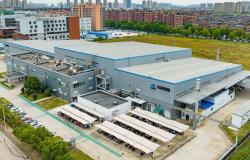A loose and too long network does not connect, does not hold, dissipates. The network of wholesale markets in Italy it is the largest in Europe, but does less business than its competitors. They operate in our country 137 markets wholesale: six times higher than in Spain (25 markets) and France (22 markets). But the greater density of structures – mostly small in size – compared to other European realities, corresponds to a lower turnover. Italian markets gross 10 billion euros a year, compared to 14 in Spain and 12.5 in France. Wholesale markets they manage half of the Italian fruit and vegetable marketing (first sector at an aggregate level of Italian agriculture with a value of 17 billion euros), 33% of fish and 10% of meat. Shares which, with the exception of fruit and vegetables, are significantly lower than those of similar situations in other European countries.
The investigation made this known “Wholesale markets in the agri-food supply chain”, hosted by Ismea at the reference network of Italmercati (made up of a network of 22 structures in which over 4 thousand companies operate including wholesalers, intermediaries and agricultural companies, distributed in 14 Italian regions, for a turnover of 115 million euros).
For more than two thirds of those interviewed, the market operations were affected by the inflationary pressure on fuels and the logistics system, the increase in prices of energy products and the impact of inflation on agri-food goods.
Obstacles to overcome
There fragmentation so penalizing in terms of takings, and not only that, it certainly requires a rationalization of the entire market system, which maintains some of its own rigidities that do not seem to keep pace with the evolution of the agri-food system. Among these, some logistics services such as transition to daytime working hours, to which the theme of generational change is closely linked. And again, themodernization of structures (lacking efficiency of the cold chain), followed by one digitalisation for managing goods reservations.
As reported by Ismea, 76% of agricultural companies declare that they are not interested in this type of marketing; weighs, in this sense, for 31% of those interviewed non-flexibility of market hours.
Markets need “more targeted funds and services”
The general director of Ismea, Maria Chiara Zaganelli, declared: «Our investigation has highlighted the critical factors that do not allow us to ensure the direct presence of farmers in wholesale markets. With respect to this need, the markets could provide facilitation services to small producers, even with a different programming of opening hours”. Zaganelli then underlined the importance of continuing to work to rebalance supply chain relationships, favoring the bargaining power of farmers.
The president of Italmercati Fabio Massimo Pallottini explained that «the fragmentation of the wholesale market sector in Italy has led many of these structures to lose relevance and strategic importance for the country. For concrete development, it is essential that political actions invest in a targeted manner in wholesale markets. It is wrong to finance the same sums for all markets, small and large.” Finally, Pallottini hoped for the development of a market system that operates through a corporate bond, on the Spanish Mercasa model.
Customers always the same
Another central theme, highlighted by Ismea, is the share of sales by customer type. The photograph taken in 2014 does not differ much from that of 2023. Specifically, in 2023 thehoreca marks a share of 6% compared to 5% in 2014 (only +1%) and the modern distribution represents 18% compared to 14% in 2014 (+4%). The traditional detail drops slightly (-2%) in 2023, compared to 2014, but still represents the largest share (37%). Almost stable intermediaries and exporters foreign and Italian (equal to 11% and 7% respectively in 2023). It hasn’t taken off in ten yearse-commerce: from 0% in 2014 to 1% in 2023.
In the markets prices are ok for farms
The large concentration of trading and trading in wholesale markets succeeds in guarantee adequate prices to farms that sell their products directly they can maximize margins and defend against their erosion along the supply chain. The reasons for satisfaction for the companies that declared they use wholesale markets with their own sales spaces (equal to 14% of the total interviewed) are: the possibility of obtaining a higher price compared to alternative marketing methods and therefore obtain a greater profit. Among the other advantages: the opportunity to reach a large number of customers and start new collaborations with other agricultural companies to expand the offer.
You become virtuous
The structures participating in Italmercati contribute to renewable energy production, 60% of these have installed systems partly financed by the Pnrr. Almost half of the sample interviewed declared that more than 75% of investments in their market will be financed by the Pnrr and making the logistics system more efficient is the main objective. As regards the issue of food waste, to date almost all markets provide for recovery activities for unsold products.
The Pnrr and wholesale markets
With the ministerial decree of 5 August 2022, Masaf has allocated 150 million euros from Pnrr funds to support investment projects aimed at modernize wholesale agri-food markets and improve their logistical capabilities. Of the markets participating in the Italmercati network, 19 have applied for access to the benefits, for over 164 million euros, and of these, 14 have obtained the benefits for a total of almost 120 million euros. The overall value of the approved projects exceeds 151 million euros. The objectives of these projects fall within the scope of reducing environmental impacts and ecological transition and digitalisation.
The following emerged from the Ismea survey carried out at the markets some critical issues relating to the management of the initiative. First of all, the investment applications did not take into account the real impacts on the local and national agri-food system. In fact, no reward associated with the physical and economic dimensions of the structure that presented the project was envisaged, neither in terms of increased premium nor access priority. Furthermore, bureaucratic delays have slowed the implementation of projects.
On 17 May 2024, a Masaf decree allocated the residual resources of the Pnrr financing of the “Ports” and “Enterprises” lines to increase the allocation in favor of the “Markets” line, bringing it to over 268 million euros.
The markets present themselves
Wholesale markets are a very important traditional channel in the distribution and promotion of fruit and vegetables, as well as in price formation. However, their knowledge is not taken for granted even among supply chain workers. For this reason, eight of the twenty-two Italmercati fruit and vegetable markets, on which the Ismea study was based, were the protagonists of the “Wholesale fruit and vegetable markets appear” curated by Anna Parello, agronomist expert in communication for fruit and vegetables, and published in the Frutticoltura magazine. The following were interviewed: Char From Rome, Sogemi from Milan, Caat of Turin, Maap of Padua, Caab from Bologna, M or F of Fondi, The Pescara Valley of Pescara and Mercafir from Florence.





